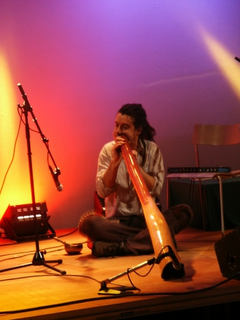

These are two images from my performance at the
Fatta 05 festival (Much Thanks to
Kirill for them).. I like the first one, the second looks like I am in pain, maybe I was as I am not getting to play as much as I would like to over the winter. But that is usually the case here in the far north.
Yesterday was my birthday...Thirty Six years since I first drew breath and filled my eye with light. I did not really tell anyone and the celebrations of it were kept to my partner and child with a phone call from my sister and a call and present from my mum. From my immediate family I scored a guitar which is interesting as I have not played such for 20 years. It was then the inspiration I could have felt was crushed beneath the pedagogic weight of a teacher who followed a rote learning method and had not yet come to terms with the music revolution instigated by Elvis Aaron Presley, let alone the Sex Pistols. However, I can still remember how to play "Dark Side of the Moon" by Pink Floyd which one of my parents friends showed me when I was about 11 years old.
When I got to university (1988) suddenly anyone who was interesting was playing guitar. I felt so self conscious about it I bought a sitar instead so nobody would know if I was good or bad at it. In the meantime I found many friends across the whole east coast of Australia who were in the thick of the punk rock experience and I even participated as a provider of words in late night recording sessions at friends houses or as lyricist for a few bands. I was also a roadie for an ex-girlfriend's band, lugging gear and going to gigs in a dedicated fan-like way. I once danced to the music of my friends as band around a huge bowl of burning aftershave at a pub in our hometown. Dressed in a monk's cowl with make-up, in my hands a tambourine and Balinese devil mask, until the publican turned on the lights and forced us to stop. Something about fire regulations??
I fell in love with the sitar after seeing Ravi Shankar play in Mumbai on 26th January 1990. I struggled with the complex instrument for abut 5 years but then when I finally got back to India I could not bear the seclusion of practicing raga scales alone in my room, as all the other sitar and tabla students where doing, when outside was the most incredible tableaux of color, sound, architecture and people I had ever seen. I studied yoga instead and spent my evenings going to concerts of Indian music (I saw Ali Akbar Khan give a 6 hour sarod recital among many great experiences). Evening concerts on the Deshaswamedh Ghat at Varanasi are an experience I will never forget.
Before I went to India for the second time (1996) I had discovered performance art, another example like exotic instruments where many don't actually have the experience to evaluate whether what they are witnessing is meaningful, good, bad or otherwise (most just stared with an astonished look on their faces). In the art college scene of Sydney at the time, taking your clothes off and working with animal carcasses (whole or dissected) were favorite mediums of address in the installation and performance community. I and several of my friends had met and listened to
Mark Pauline of
Survival Research Laboratories (Sydney College of Art 1994). We had decided we were not going to go for flesh, we were going for metal. It was at this time I started playing metal tubes like a didgeridoo and participating in a group of musicians who were all actually art students, or was it the other way round??? Sensory overload was our aim, redundant technology was our means. For a taste of Senslesss click
HERE (Visualize: looped films and projected videos and stills, fire jugglers and twirlers, acrobats, trapeze artists,, sculptures, paintings, flashing lights and costumes all in a huge warehouse space, Sydney College of Art, 1995).
Since then it has been just building upon the foundations laid ten years ago. Branching out into the visual, literary, digital, multimedia, 2D, 3D, and always
sound sound sound. What was the point to all this reminiscence?? Oh yea......The guitar.
Over this weekend of my birthday I've been deep in sound. Making recordings, working on stuff I've already recorded and organizing things with present musical collaborators (some of whom have been helping me since the bad days of the sitar...Which I also still have) around the world (god bless the P2P Internet I say). A great way to spend a birthday..........







